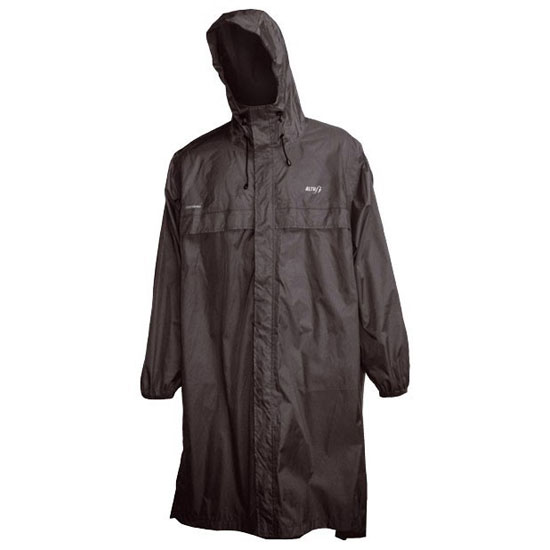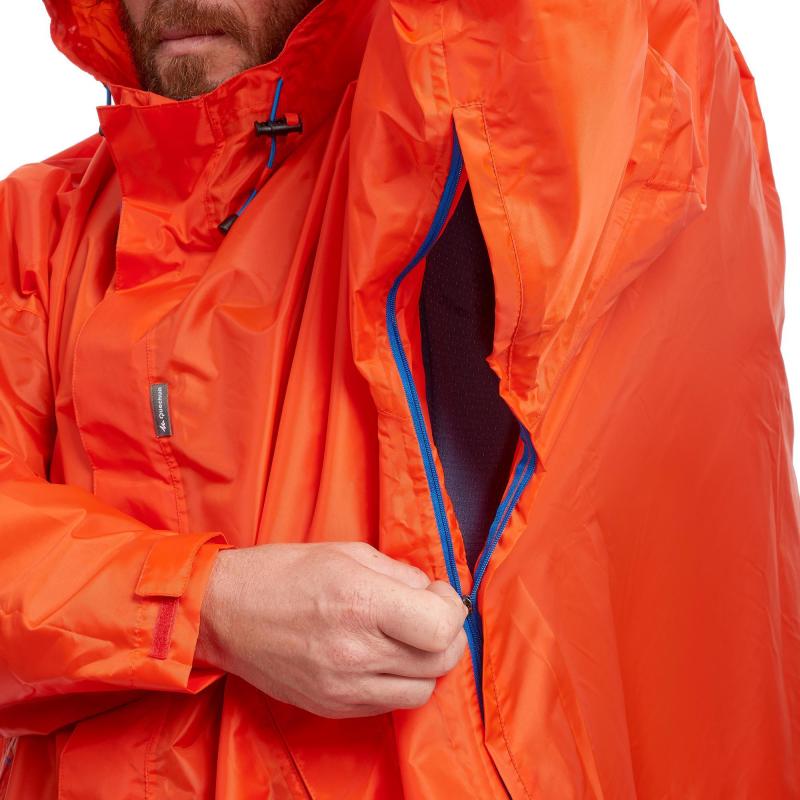When getting rain gear for something like a Camino and not just a quick walk in the park, most people will go with what they know: rain jacket and ditto trousers, and a rain cover for their pack – it often comes with the pack these days. So far, so good. In most cases it will keep them dry, at least until they start sweating inside the rain suit, but it is not unusual to get soaked from the inside rather than the outside after a while, especially if walking uphill or fast to get out of the rain. Actual waterproof and breathing rain suits do exist but they often cost a lot – it seems you get what you pay for.
But there is another – better? – option.
When the same most people think about a rain poncho, they imagine a flimsy rectangle of shopping bag style plastic with a hole and a hood, something that will whip around them in the wind and rip and fly away at the first opportunity. There are however a lot of ponchos out there that are more like a rain coat with space for a backpack, and these are in my humble opinion perfect for things like the Camino. They cover most of you in one, replacing the rain jacket, hood or hat and pack cover. The only things exposed to the rain and wind will be your legs and hands. Your hands can be pulled into the sleeves or the poncho body, and legs can be protected by rain trousers or gaiters. Or in the summer, roll your trousers up and just get wet – skin dries faster than fabric anyway. A roomy poncho also has better air circulation and ventilation than a jacket cinched in at the waist and armpits by your pack, and will help with the wet-from-the-inside problem.
With a poncho you don’t have to take the pack off to dig out the gear, then put the pack cover on while holding the rain suit between your knees, dump the pack on the ground while pulling on jacket, hurry to get trousers over shoes or stand wobblily on one leg – or try to find somewhere dry to sit – to take shoes off to get rain pants on, before picking the pack back up again and tightening it over the rain jacket where it can rub on the material and eventually let the water in.
I am very happy with my quick deploy rain defense: Dive into the poncho, velcro up the gaiters if needed. Done. And when walking in a skirt, pull the rain trousers over the running tights, drop skirt over trousers – it is protected by the poncho already. The poncho lives in the top lid of my pack, so I can actually reach it whilst walking alone: just unzip, pull out, zip up, pull on, it only takes a few seconds. When I carry my daypack for practice walks, the poncho is in the side pocket. It is still very easy, just take the pack off, get poncho, get into the poncho – but not sticking my arms out, then lift the pack into the poncho and snap it on. Looks odd, works great.
My first poncho was a classic Altus Atmospheric, which was a Camino staple in 2009. Lots of pilgrims wore them, they were available in most gear shops along the way. Then Altus came out with a lighter, brighter and sadly shorter poncho which was less of a hit. These days Decathlon have come out with a similar model but with pit zips for even better ventilation – affordable, but on the heavy side.
They both have zips at the front which means you can open it up after the rain stops, and leave the poncho hanging over the pack to dry – or ready for the next downpour.
Another poncho type I like is the over-the-head one with open sleeves because it is lighter (less sleeves and zips) and has great airflow because of the openings. Helsport with open sleeves to the left, Ferrino Hiker on the right. The Helsport has only some extra material at the back, the Ferrino has a proper hump which can be snapped down when you don’t have a pack.
I prefer a closed side poncho for less flap and billow in the wind, but others prefer ponchos with snaps or poppers along the sides, like the Sea to Summit ultra-sil poncho on the left, or even square-ish ponchos that can be opened up and used as a tarp or simple shelter by pegging it out and using a walking pole to create headspace. My initial thought is that anything with a dual purpose is great, but … if you use the poncho as a tarp, you are left with no rain gear if you need to nip behind a bush or it doesn’t cover you completely. Depends what kind of trip you need it for I suppose.
Combined with a pair of waterproof trousers or gaiters a poncho will keep you, your pack, your sidebag or camera bag and anything else hanging off you and your pack, nice and dry. It’s quick and easy and also provides extra protection against cold winds. If it flaps too much, tie a piece of string, a bungee or a webbing belt around it to keep it in check. You’ll look like the love child of a tent and a small mountain range, but you’ll be snug and dry!






5 thoughts on “Why a poncho?”